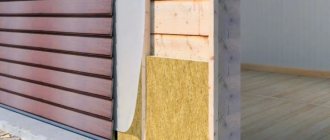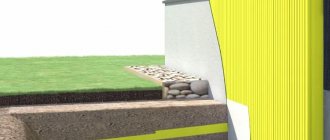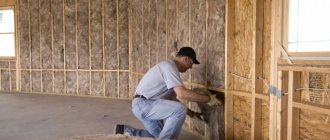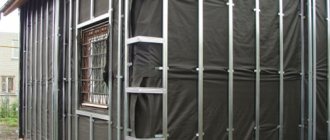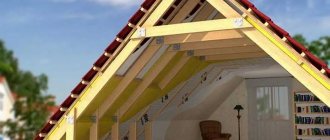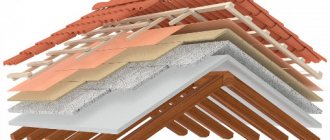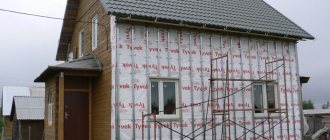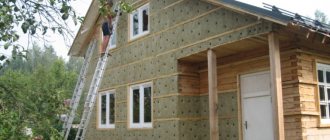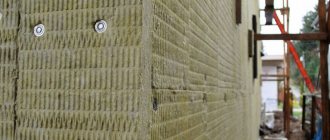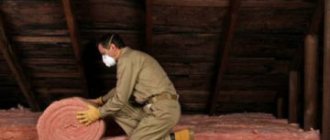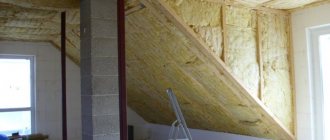Siding has a lot of positive characteristics, but cannot boast of thermal insulation properties. That is why, when finishing residential buildings, the walls are first insulated, and only then the covering panels are attached. Which insulation for siding has the best properties, what criteria should be used to choose it, and how to properly perform insulation with your own hands - this will be discussed in the article.
Insulation for siding
Choice of thermal insulation
The need to insulate a building intended for permanent residence is obvious, otherwise a brick or foam block house will not allow you to feel comfortable in the cold season and its use as a living space will be reduced to zero.
The situation with wooden structures is no better, because, despite the fact that natural material retains heat well, it is clearly not enough in frosty weather, and the use of additional heating devices will negatively affect your family budget. Insulation installed externally between the cladding and the wall minimizes heat loss, and this is exactly what we expect from this material. What do thermal insulation manufacturers offer us, and what characteristics should it have? Professional builders advise choosing the following materials for wall insulation:
- mineral wool;
- cotton wool based on basalt fibers;
- glass wool;
- ecowool;
- polyethylene foam;
- expanded polystyrene (extruded).
Comparison of the characteristics of foam plastic and mineral wool
If we talk about the requirements for thermal insulation, they come down to several positions:
- Low thermal conductivity coefficient.
- Resistant to sudden temperature changes.
- Low level of hygroscopicity.
- High fire safety.
- Resistance to chemical agents and biological organisms.
- High density coefficient.
If you carefully study the instructions supplied with the insulation for external walls, you can conclude that the optimal choice of thermal insulation would be polystyrene foam, mineral, basalt and glass wool, which in practice have proven to meet the necessary requirements. We invite you to take a closer look at each of these insulations.
Fiber insulation
Installing insulation for house walls under siding
The form of release of fibrous thermal insulation is rolls or mats. Such construction products have a number of positive qualities:
- low thermal conductivity;
- resistance to biological organisms;
- no combustion;
- ease of installation;
- affordable price.
Methods for attaching mineral wool to wooden walls
Mineral wool copes well with its main task on buildings made of any materials, be it wood, brick or concrete. To insulate the walls of a house from the outside, it is better to give preference to cotton wool produced in slabs, which, due to their rigidity, hold their shape and do not slide down, as can happen with their rolled counterparts. Do not forget that such insulation under siding has a high degree of vapor permeability, which means we will need a vapor barrier that prevents the formation of condensation, which negatively affects the performance characteristics of mineral wool. If we talk about ecowool, its composition has been improved by the addition of borax and boric acid, which significantly improves the heat and sound insulation properties of the material.
Polyurethane foam (PPU)
Insulation of house walls with polyurethane foam
This modern product is very effective, because it allows you to insulate the walls of a house in a short time, while we get a uniform, hermetic coating, although for a lot of money. The hardened foam has a high coefficient of wind protection, it also repels water perfectly and lasts for more than half a century. To apply it to the surface of the walls, you do not need to install lathing, and this is also a significant advantage, but this does not apply to those cases when you decide to use siding as exterior cladding. Properly executed technology for applying polyurethane foam guarantees the absence of cold bridges, and the low weight of the insulation does not create additional load on the supporting structure of the house and its foundation.
Styrofoam
Insulation of house walls with foam plastic
The main advantages of polystyrene foam are:
- light weight;
- low cost;
- ease of installation.
This insulation is attached to the flat surface of the walls of the house using an adhesive base or using dowels.
The same applies to the coefficient of vapor permeability, which here is far from being at the best level, and it is precisely these shortcomings that do not allow us to consider polystyrene foam the best solution for insulation under siding.
Video description
We will dwell in more detail on insulating a house with polystyrene foam.
Find out how safe polystyrene foam is in our video: See also: Catalog of companies that specialize in insulating country houses.
- Expanded polystyrene is used to insulate building foundations. The material resists moisture well and conducts heat poorly. The main disadvantage is the high cost. Therefore, the use of the material is limited to the foundation of the house.
Sometimes polystyrene foam granules are used Source fasaddomstroy.ru
- Polyurethane foam (PPU) has a liquid structure, low thermal conductivity, and is resistant to moisture, mold, and rodents. The material is applied using special equipment. Good sound insulator. Application in liquid form allows you to cover the surface without joining seams. The disadvantages are poor resistance to ultraviolet radiation. It is necessary to have skills in working with equipment for applying to the surface.
This is how polyurethane foam is sprayed Source buildes.ru
- Extruded polystyrene foam is resistant to moisture, mold, and retains heat well. The big disadvantage is poor fire resistance.
Extruded polystyrene foam boards Source pt.decorexpro.com
- Glass wool is fire resistant, lightweight, easy to install, and cheap. This is one of the most popular materials. The disadvantage is the need for special human protection during installation of the material.
Glass wool is available in slabs and rolls Source saucyintruder.org
Covering a house with siding and insulation
There are two main ways to attach insulators.
- On a wooden frame or metal sheathing.
- Adhesive - only suitable for hard, smooth surfaces.
The first method is more reliable and universal. It may be labor-intensive, but, as a rule, it is what is used.
Preparatory work
Start with surface preparation.
- Log house, frame and panel house - first you need to eliminate all defects so as not to waste time dismantling the panels. All excess decor is removed, which will still not be visible under the coating. The voids are expanded and cleared. The mold is removed. Then you need to treat with antiseptics and fire retardants - fire retardants. Cleaned cracks, cracks and chips are covered with wood putty and sealed. If the basement has not been hydro- and vapor-insulated, it is advisable to do so so that moisture does not accumulate inside.
- Brick, concrete, porous blocks - the surface is cleaned, defects are eliminated using cement mixture, plaster and putty. All voids are treated with antiseptics before filling. If necessary, the foundation is waterproofed. If you plan to install a porous mass with glue, the base is primed.
Pixabay
Frame installation
It is necessary for attaching the casing. The material used is a metal profile or wooden blocks with a maximum cross-section of 50x50 mm. To prevent ice from forming inside. Work is carried out at positive temperatures. Metal is more reliable. It is not subject to temperature and humidity deformation, does not dry out and does not lose strength over time. To create the lathing, you will need PS rack parts 50x50 mm and ceiling PP 60x27 mm.
The guides are set in increments of 0.5-0.6 m. For plinths it is 0.4-0.5 m. They are placed perpendicular to the siding panels. It is usually directed horizontally. The bars are coated with antiseptics and secured according to the markings. It is advisable to pre-drill holes for screws in them and in the base. Dowels are inserted into the base.
Metal parts are installed on hangers. First, their locations on the wall are marked, then holes are drilled. Dowels are inserted into them. Step - 0.5 m or less. Suspensions are elongated metal plates. They are bent into the shape of the letter “P”, then guides are inserted into them and screwed in place.
Jumpers are installed to increase the strength of the sheathing. It can perform its task without them, but with jumpers the reliability will increase significantly.
A polyethylene film or porous products based on it, which perform the function of a vapor barrier, are attached to the ground floor and foundation. It is laid overlapping and secured with tape. It should not be pulled. The corners are covered in solid pieces. The seams must be absolutely sealed.
Instagram @remsistem63
Instagram @remsistem63
Frame technologies differ from each other in complexity. The fastest method is suitable for smooth walls. The surface is covered with hard slabs that have a shell, and a sheathing is mounted on top. It can only be used in warm regions, as it does not allow the coating to be made thick enough.
For the middle band, other technical solutions are required. They depend on the material used.
Laying insulation
For mineral wool and polystyrene foam panels, vertical wooden slats are sufficient, the height of which is equal to their thickness. The pitch of the slats is equal to the width of the slabs.
Penoplex is recommended to be attached to a metal frame. Suspensions and horizontal jumpers are used as supports. For fixation, dowels with a wide head that do not fall through the loose porous mass are also used. To ensure that the joints do not coincide, the rows are offset - otherwise the cold will penetrate into the room through the cracks. The voids are sealed with polyurethane foam.
PPU is sprayed onto the sheathing with a spray gun with a nozzle. Only professional builders have such equipment.
Pixabay
External insulation technology using foam plastic
To insulate the walls of a private house from the outside, you can use polystyrene foam. The procedure for foam insulation involves the sequence of work performed:
- preparation of walls (cleaning of debris, sealing cracks, priming);
- applying the necessary markings;
- attach a profile at the bottom of the wall, which will serve as the basis for the even laying of the first row of slabs;
- attach the foam by applying the adhesive solution, starting from the bottom corner. The second row of sheets is fastened in a cross pattern;
- after the glue has completely dried, secure the foam with umbrellas;
- the joints are sealed with polyurethane foam, if large, with pieces of polystyrene foam. After hardening, excess foam is cut off;
- To finish slopes and corners, you should use special corners that are glued to the reinforcing mesh tape.
Laying sheets in a checkerboard pattern
Fastening sheets
Sectional diagram of insulation
Further along the wall, a reinforcing mesh is attached to the layer of glue and leveled with a spatula. After the glue has dried, the surface is primed and covered with finishing plaster or other decorative materials.
CAREFULLY!
It is better not to insulate wooden houses with polystyrene foam, since with breathable wood it is better to use porous insulation that can allow moisture and air vapor to pass through.
In this case, mineral wool is ideal.
What insulation materials are suitable for this?
Let's take a closer look at each of the suitable thermal insulation materials. Let's start with the cheapest, that is, glass wool.
Option one. Glass wool
A budget variety of mineral wool, so to speak. The material is quite dangerous, since when working with it, glass dust is released, which is extremely harmful to the respiratory system. When choosing this insulation, be guided by the fact that it will cost several times cheaper than its analogues (more on prices a little later).
Here are the main characteristics of glass wool:
- thermal conductivity index – from 0.029 to 0.041 W/m*K;
- the use of phenol-formaldehyde resin during the joining of fibers, due to which, in fact, toxic substances are released;
- the specific gravity indicator fluctuates between 11 and 25 kilograms per cubic meter;
- high danger to the human body (possible severe irritation of mucous membranes and skin);
- the vapor permeability indicator reaches 0.6 mg/m*h*Pa;
- the material is made from sand, limestone, broken glass, soda and borax;
- glass wool is a non-flammable material;
- high resistance to aggressive chemical environments;
- operating temperature – from minus 60 to plus 250 degrees;
- the fibers of the material do not absorb liquid at all;
- moisture absorption (if glass wool is briefly immersed in water) is approximately 0.8 kilograms per square meter.
From all that has been said above, we can conclude that glass wool would be an ideal insulation material if not for a number of harmful factors; more specifically, he:
- does not burn;
- resistant to high temperatures;
- moisture resistant;
- almost does not allow heat to pass through;
- not afraid of bacteria and fungi.
But health still comes first. That is why in a number of countries glass wool was banned from being used in civil construction. In short, in our case this material is not suitable at all.
Option two. Mineral wool
A common material, including as insulation for siding. It has all the advantages of the previous option, but it does not have its disadvantages. In addition, it is worth noting the long service life of mineral wool, reaching 70 years.
Over the years of operation, this insulation for the walls of a house outside under siding has shown itself only from the best side. You can easily install it yourself, but in the process you must strictly follow all the rules provided for by the installation technology.
In short, if you plan to use mineral wool to insulate walls under siding, you must take care to protect the material from getting wet. This can be achieved with the help of special membranes - moisture, wind and vapor protection (more on this a little later). The heat insulator in this case will be wrapped in a waterproof film. Manufacturers claim that such protection functions like a valve, since it only allows steam to pass out. Steam will not penetrate into the material from inside. What about the “breathing” of the walls, many will ask? The fact is that such “breathing” does not involve the movement of air through the walls; a ventilation system is used to ensure air exchange - even old log houses “breathed” only thanks to the stove draft, and not due to air penetration through the walls.
In short, mineral wool is a good option for thermal insulation of the outside walls of a house under siding. Go ahead.
Option three. Styrofoam
This material is characterized by a fairly low thermal conductivity (no more than 0.043 W/m*K), and therefore is rightfully considered one of the most effective modern thermal insulators. It is used in many areas, including for insulating the outside walls of a house under siding.
And it’s not surprising, because polystyrene foam has many advantages. So, it is quite easy to install, and it does not need waterproofing. It is also easy to work with polystyrene foam - it weighs little, is easy to cut, and does not emit any harmful dust.
Extruded foam plastic has a minimal thermal conductivity, but it:
- very durable;
- resistant to bacteria, fungi;
- not afraid of high humidity.
Its surface after installation will be protected by siding, and therefore the negative impact of the environment will be minimized. Therefore, extruded foam plastic is one of the best options for insulating the outside walls of a house under siding, especially since its modern varieties are safe both from a fire point of view and from an environmental point of view.
How to choose?
The parameters of each home are unique and require special attention. Installation work will vary depending on what kind of building it is: a country house among a large, ventilated space or a building among houses of the same type where there is no free movement of air flows.
The correct selection of the necessary materials is one of the difficult issues when doing your own cladding and insulation. The choice largely depends on the building material from which the house is made. For example, for construction from solid wooden beams, mineral wool is preferable, and for brick or cinder block, almost all types of insulation are preferred.
It is also recommended to use mineral wool for a timber frame house. This is due to the fact that it is the most fireproof material for wooden buildings.
As for external walls made of aerated concrete, experts advise insulating them with penoplex.
In turn, professionals in the field of construction and installation have identified a number of qualities that insulation should have.
Based on these standards, it will be much easier to make a choice:
- the most important quality is low thermal conductivity;
- the insulation must be hydrophobic or absorb moisture in minute quantities;
- it must “maintain its shape” (not crumble, slide, flow, or change shape due to temperature);
- Particular attention should be paid to its safety for humans; the material must also be fire-resistant and not emit pungent odors when heated;
- It is unacceptable to contain substances that will promote the growth of bacteria, fungi and mold.
Siding also requires attention. Its choice must be approached wisely, since it is affected by natural phenomena (wind, rain, snow, temperature changes, etc.). Each type of siding has its pros and cons, but among the wide variety, the greatest preference is given to vinyl siding panels. Thanks to its properties, it tolerates “street conditions” well, does not fade in the sun for a long time, and is also a “breathable” and safe material.
If you choose metal panels, then you should think about the level of complexity of their installation. A beginner in this matter cannot cope on his own. As for their characteristics, do not forget about their susceptibility to corrosion. Plus, when it rains slantingly, water drops hit the walls and create a high level of noise.
If you still have doubts about the choice, then real consumers will be the best guide in this matter. The best thing to do is talk to the home owners. From them you can find out what pros and cons they identified during operation.
Choice of shape and size
When making boxes, it is important to carry out all the steps in stages - this way the work will progress more smoothly and will not require too much time. The first step is to determine the shape and size
These parameters depend on the amount of material, location and purpose. In addition, the degree of difficulty must correspond to the skill of the manufacturer. For beginners, simpler options are better:
- square;
- rectangular.
Next, you can try to make a round box or in the shape of a polyhedron. These varieties are the most common and traditional.
Since cardboard cuts, bends and crumples quite well, you can find more complex products in the form of a heart, shell, suitcase, watch and even a piano. In the same vein, you can make a hiding place, disguised in the form of a book or the base of any figurine.
In addition, the box may have:
- concave or curved sides, cover;
- legs, handles, hinges, locks and other fittings;
- drawers.
Decorative boxes are designed to store:
- money;
- documents and photographs;
- jewelry and costume jewelry;
- business cards and stationery;
- hours and much more.
Boxes can be either very tiny - up to 5-7 cm, or large - up to 20 cm or more. Small ones can be placed on small surfaces - open shelves, bedside tables, tables. Volumetric ones take their place in the closet. In principle, their parameters are limited by the size of the cardboard sheets.
Frame houses
For external insulation of frame houses, mineral wool is most often used (see photo). Experience shows that the price-quality ratio is the most acceptable. But the material must be isolated from moisture and “dew point”. This is done using a vapor barrier and membrane film.
Despite the negative attitude of experts towards polystyrene foam, homeowners very often use this material for insulation. Cheapness and the absence of the need for additional moisture, noise, and vapor barriers play a decisive role.
Insulating the frame with polyurethane foam by spraying also has many advantages. For frame houses, as well as for brick and foam concrete, this is an excellent option.
Basic requirements for heat insulators
The domestic building materials market offers a huge selection of insulation materials to suit every taste and wallet size.
Thermal insulation of a house from the outside must effectively solve the assigned problems and therefore it is important that the insulation has the following properties:
- Low thermal conductivity coefficient, in the range of 0.03-0.042 W/m2.
- Insensitive to temperature fluctuations.
- Low hygroscopicity.
- Resistance to biological and chemical influences.
- Fire safety.
- Environmentally friendly.
- Resistance to deformation.
Now it is necessary to say a few words about the required thickness of the heat insulator for external insulation of the house. The choice of one thickness or another is determined by three values: the thermal conductivity coefficient, as well as the material and thickness of the walls of the house. Thermal conductivity was discussed above; next, let’s look at the table of the dependence of the thickness of the insulation on the material and the thickness of the walls of the building.
| Wall material | Thickness of load-bearing walls, mm | Required thickness of heat insulator, mm |
| Concrete | ≥ 230 | from 150 |
| Brick | ≥ 510 | from 100 |
| Wooden beam | 150 | from 100 |
| Log | ≥ 200 | from 50 |
Do not forget that the choice of material for insulating the outside of a building is not limited to just one insulation material. This includes high-quality wind protection, fasteners for fixing the thermal insulator to the wall of the building, and material for creating the sheathing.
Features of insulation of wooden buildings
Any wood has the ability to absorb moisture. Treatment with various impregnations significantly reduces the hygroscopicity of the material, but cannot completely eliminate it. With normal ventilation, moisture effectively evaporates without having a negative effect on the material, and an optimal microclimate is maintained in the house. But a violation of air exchange leads to the accumulation of condensation and swelling of the wood, as a result of which fungi develop in it, rot appears, and the air in the house becomes musty.
Mold on untreated house frame boards
To avoid such problems, you should follow several rules:
- do not insulate damp walls;
- use only vapor-permeable insulation;
- The thermal insulation on both sides must be covered with a waterproofing membrane;
- leave an air gap between the finishing and the insulation.
Scheme of waterproofing and proper insulation of a wooden house
If you plan to paint wooden walls or only need to insulate the seams, paint and sealant are also chosen that are vapor-permeable, for example, acrylic-based. And, of course, before insulation, the surface must be well prepared, cleaned of dirt, moss, mold, and repaired.
It is especially important that there are no wood-boring beetles in the walls, because under a layer of insulation they will continue their destructive activity until the tree becomes unusable
You cannot insulate walls if there is a bark beetle.
Kinds
Among the most common types of insulation for siding, several should be highlighted.
Expanded polystyrene
First of all, this is a well-known polystyrene foam. It has a high thermal conductivity coefficient because it is formed by many tiny balloons. Despite its high thermal insulation properties, the material is being used less and less because it is environmentally unsafe (it releases dangerous styrene during operation), is flammable (supports combustion, releases toxins when the temperature rises), and attracts rodents.
A modern modification is extruded polystyrene foam, the higher technical characteristics of which are achieved by isolating the air chambers from each other. This increases the moisture resistance of the material, since it does not absorb liquid, and also increases its environmental safety and fire resistance.
Mineral wool insulation
Another popular group of insulation materials includes slag wool, glass wool and stone wool. The first (slag wool) is not used for insulation because it does not have the necessary characteristics.
The thermal conductivity coefficient of mineral wool insulation is similar to that of expanded polystyrene. However, heat retention occurs due to the structure of the material. Mineral wool insulation consists of the finest long fibers arranged in a chaotic manner. Air layers are formed between these fibers, which provide a thermal insulation effect.
Glass wool, which is based on molten broken glass and quartz sand, is more elastic and soft, and is therefore suitable for finishing surfaces with complex configurations. Among the disadvantages are the tendency to absorb moisture, flammability (ignition temperature - 500 C), the need to use a protective suit, glasses and gloves during work (thin and sharp fibers penetrate the skin, causing irritation).
The more expensive stone wool is a non-flammable material because it is made from molten rocks. Their melting point is over 1200 C. Among the advantages is higher moisture resistance. It does not chip like glass wool, although a respirator should be used when working with any mineral wool insulation. Mineral wool is an environmentally friendly material. It is produced in sheets, rolls, and if we are talking about high-density insulation - in mats.
Polyurethane foam
This insulation is sprayed onto the surface, which ensures reliable adhesion of the material and the absence of seams and gaps. It is characterized by high thermal efficiency, due to which a layer thickness of 2–3 cm is sufficient to achieve an optimal thermal insulation effect, as well as environmental friendliness, non-flammability, and moisture resistance.
During the spraying process, toxic elements are released (evaporate as the polyurethane foam hardens), so application requires the use of a suit and a respirator. The disadvantages are low vapor permeability (therefore, it is not recommended to spray insulation on wooden walls) and the need to use special professional equipment.
Penofol
Foil insulation based on polyethylene foam. The latter itself has a low thermal conductivity coefficient, however, the main thermal efficiency of the material is provided by a thin layer of foil. It reflects up to 97% of the heat, so the insulation works on the principle of a thermos - it prevents heat from escaping from the room during the cold season and keeps it pleasantly cool on a hot day.
Penofol is attached with a foil layer inside and allows you to avoid the use of additional waterproofing materials. Among the advantages are small thickness (up to 5 mm), low weight, and high sound insulation performance. Release form: rolls.
Stone wool
Of all the varieties of stone wool, basalt insulation is considered the most popular. It is distinguished by the lowest content of binding components, which includes formaldehyde resins and phenol, which are hazardous to health, and therefore is one of the most environmentally friendly materials. The fibers that make up the insulation are not scratchy and quite smooth, so they do not cling to clothing, do not cause irritation on the skin, and you can perform work without protective gloves.
Manufacturers produce stone wool in the form of mats, soft, semi-rigid and hard slabs, and in rolls. For installation under siding, rigid and semi-rigid slabs are most convenient, but roll insulation is more suitable for horizontal and inclined surfaces.
Advantages of stone wool:
- the material is easy to cut, light in weight, and does not create difficulties during installation;
- does not burn and does not emit harmful substances;
- microorganisms, including fungi, do not develop in it;
- reduces noise level by up to 20%; service life is 40-50 years without loss of basic characteristics.
Minuses:
- the production of the material requires high costs; accordingly, prices for stone wool are quite high;
- when cutting and shaking the material, thin fibers break and form very fine dust, which easily penetrates the respiratory tract. As a result, a respirator should always be used during thermal insulation work.
There are many manufacturers who, to reduce the cost of the manufacturing process, use various industrial wastes instead of pure rocks, but at the same time pass off their products as high-quality basalt insulation. It is very difficult to visually recognize a fake, especially for an inexperienced person, so buy stone wool from well-known, time-tested brands.
Nowadays the following manufacturers enjoy a high reputation in the market of thermal insulation materials:
Rockwool;
Knauf;
Ursa;
sover;
TechnoNIKOL.
Requirements for insulation
A few words need to be said about the requirements for this material.
It must have the following properties:
- Durability;
- Aging resistance;
- Non-flammability;
- Biological resistance;
- Keep in shape;
- Easy and tight to install;
- Have excellent thermal insulation properties;
- Moisture and vapor permeability;
- Wind resistance.
These properties are characteristic of most modern thermal insulation materials. Currently, insulation materials such as mineral wool, ecowool, and polystyrene foam are used to create a ventilated facade under siding.
Characteristics of polystyrene foam insulation
Styrofoam
Polystyrene foam has very low hygroscopicity, in which it is significantly superior to fiber insulation. Walls lined with foam plastic also do not require additional wind protection. This is one of the most budget-friendly insulation options, although not the most effective. Due to the vapor permeability of the material, it is necessary to regularly ventilate the room to prevent condensation from accumulating on the walls.
Styrofoam
Pros of polystyrene foam:
- affordable price;
- low thermal conductivity;
- light weight;
- ease of installation.
Minuses:
- In terms of sound absorption, foam plastic is inferior to other types of insulation;
- sheets of material break easily, so care is required during transportation and installation;
- foam is damaged by rodents;
- It is a flammable material and produces toxic smoke when burned.
Insulation of facades with foam plastic
EPS (extruded polystyrene foam)
This material has characteristics similar to polystyrene foam, but in all respects it is much better. EPS is widely used in industrial and private construction; its installation does not require much effort or special skills.
Extruded polystyrene foam
Pros:
- high density and strength of the material;
- almost zero hygroscopicity;
- excellent thermal insulation properties;
- good noise absorption performance;
- long service life;
- relatively light weight.
Minuses:
- the cost of EPS is approximately 20-30% higher than that of polystyrene foam;
- does not allow the walls to “breathe”;
- can be damaged by rodents;
- refers to flammable materials.
| Options | Styrofoam | EPPS |
| Thermal conductivity | 0.035 W/(m K) | 0.028 - 0.032 W/(m K) |
| Water absorption | 0,5 — 1% | 0,1 — 0,4% |
| Density | 11-35 kg/m3 | 30-40 kg/m3 |
| Flammability degree | G1 – G4 | G1 - G4 |
| Thickness | 20-100 mm | 40-100 mm |
| Dimensions | 500x500 mm, 600x1200 mm, 1000x1000 mm | 580x1180 mm, 600x1200 mm |
Prices for foam plastic
Styrofoam
Tools and materials
Special tools and devices are required to insulate the outside of the house with mineral wool under the siding. The material is prepared based on the required number of layers. A layer of waterproofing is taken, and a lining material, for example, roofing felt, is used as it. Protection from moisture is done by coating - using bitumen or modern compositions for work.
The next material is mineral wool. For the base, stone wool or a fiberglass variety is used. You will need a metal profile on which to attach the siding. Hardware is used for fixing to a brick base, foam block or aerated concrete.
Tools needed:
- assembly knife with spare blades;
- building level, tape measure;
- electric hammer, drill, grinder;
- bitumen finishing brush.
It is not recommended to make a frame from timber, since the material absorbs moisture and can bend over time. Siding is used as finishing.
Installation of vapor barrier and why it is needed
Do not allow the insulation to get wet. As a result, all the useful qualities of the material are almost completely lost; instead of retaining heat, its active leakage begins . Therefore, the surface of the mineral wool must be reliably protected from moisture penetration.
However, some steam will inevitably penetrate the material. In order to prevent the accumulation of steam inside the insulation and ensure its removal, a vapor barrier membrane is used - a material that allows steam to escape from the inside, but prevents it from entering from the outside. This cutoff allows you to keep the mineral wool dry and in working condition.
The main types of insulation for siding and their brief description
The specifics of installing siding require the use of insulation that can retain its shape. Therefore, bulk materials (expanded clay, bulk ecowool, etc.) are no longer needed - using them on vertical surfaces is difficult and requires the installation of additional structures.
The best option is insulation for the outside walls of a house under slab or roll siding, which allows you to install it on the walls without any problems.
The most popular insulation materials are:
- Styrofoam. The material is cheap, holds its shape well, and is easy to process. It is light in weight and does not create a load on the walls. The disadvantage of polystyrene foam is its almost complete impermeability to water vapor, which prevents steam from escaping from the walls and causes undesirable processes - wetting, corrosion of metal elements, etc.
- Extruded polystyrene foam. This is a type of polystyrene foam, but with more intense properties - rigidity, density, strength and complete impermeability to moisture or steam - everything is increased significantly compared to polystyrene foam. Being a first-class waterproofer, EPS is practically unsuitable for external insulation, since it traps moisture inside the walls with inevitable negative consequences. In addition, it is much more expensive than polystyrene foam and is not profitable from an economic point of view.
- Minvata. There are several varieties of this material, and all of them are excellent external insulation materials. They have good heat-saving properties, high vapor permeability, light weight and sufficient density to retain their shape without a rigid frame. The disadvantage of this material is its ability to swell, leading to an almost complete loss of working qualities. The solution to the problem is to use high-quality waterproofing against the ingress of water from outside.
Tips for installing insulation
- If you plan to install vinyl siding, you should use galvanized screws and nails. This will protect the metal from rust and the structure will last longer.
- When choosing mineral wool, you should ask whether it is treated with a fire-retardant mixture.
- The joints of the insulator blocks must be sealed to avoid moisture ingress.
- If you plan to use mineral wool, it is better to install blocks on a vertical surface. They have a denser structure and therefore have better insulating qualities.
- Membranes are laid on polystyrene foam and mineral wool. If you do not do this, condensation will begin to accumulate in the house. An additional ventilation gap is created by the sheathing.
- Areas around windows and doorways require additional insulation. The insulator is also reinforced at the corners of the building.
When insulating walls, you need to pay special attention to windows Source myprofnastil.ru
- To install the heat insulator, no leveling of the walls is required.
- The calculated amount of material should be increased by 5 - 7%, since some will have to be cut off during installation.
- To fix the insulator, dowels with disc-shaped caps are used. At least 5 dowels are used for each block.
When choosing how to insulate a frame house under siding, take into account the ability of the material to conduct moisture. Mineral wool is popular among consumers. It is cheap and easy to apply to the surface. Experts advise insulating such buildings using polyurethane foam.
Useful tips
We recommend starting work from the rear facade of the building - firstly, possible errors will be less visible here, and secondly, if you get to the front facade, you will already have good practice in installing siding. When the first panel is reliably defined, we proceed to extension.
So, it is quite possible to install siding with insulation yourself, the main thing is to follow the technology and in the process do not forget to once again check the quality of the work - this will save you from the need to redo it in the future.
Korovin Sergey Dmitrievich
Master of Architecture, graduated from Samara State University of Architecture and Civil Engineering. 11 years of experience in design and construction.
Siding is becoming more and more popular every day. Lamellas made from high-quality raw materials are durable and practical. This material replaced wooden panels and, due to its availability, has become a real favorite of the construction market. Unlike natural cladding, it does not require additional protection from external factors.
Probably, many will be interested in knowing how houses are insulated from the outside with siding, and we will try to give a detailed answer to this question. To begin with, I would like to introduce you more closely to the technical characteristics of the material, and they are quite good here.
Glass wool
Evgeniy Filimonov
Ask a Question
The popularity of glass wool has dropped noticeably with the advent of basalt and slag insulation on the market, but it is still used in various fields. In appearance, it is not very different from stone wool, but it is more fragile, so many manufacturers additionally reinforce the material by stitching with steel threads.
The peculiarity of glass wool is that the glass fibers, at the slightest impact, are destroyed and form fine dust, which easily eats into the skin, penetrates the respiratory tract, eyes and causes severe irritation. For this reason, you can work with glass wool only in protective clothing, a respirator and goggles.
Siding fastening
Siding is not the cheapest type of building insulation. Siding panels are subject to significant thermal expansion. Under the influence of external temperatures, the siding “walks”. They are mounted from below, having previously secured the starting rail level.
The panels are secured with self-tapping screws, screwing them into the middle of the mounting holes. Each subsequent part is snapped into the groove of the previous one.
During winter installation, the gap between the panels should be increased to 8-10 mm, which will compensate for the temperature movement of the supporting structures.
When installing, avoid the following mistakes:
- The panels cannot be mounted closely. Without a gap for thermal deformation, the siding coating will warp or lead;
- It is not recommended to attach self-tapping screws to the edges of the panels, which can lead to breakage;
- The starting guide should be fastened tightly and strictly level, otherwise the coating will be damaged.
Styrofoam
Polystyrene foam has very low hygroscopicity, in which it is significantly superior to fiber insulation. Walls lined with foam plastic also do not require additional wind protection. This is one of the most budget-friendly insulation options, although not the most effective. Due to the vapor permeability of the material, it is necessary to regularly ventilate the room to prevent condensation from accumulating on the walls.
Pros of polystyrene foam:
- affordable price;
- low thermal conductivity;
- light weight;
- ease of installation.
Minuses:
- In terms of sound absorption, foam plastic is inferior to other types of insulation;
- sheets of material break easily, so care is required during transportation and installation;
- foam is damaged by rodents;
- It is a flammable material and produces toxic smoke when burned.
Tools and materials
Below is a list of everything that is needed to insulate a wooden house with mineral wool for siding.
- Mineral wool - obviously, without it there can be no talk of any insulation. Before you go to the hardware store, take measurements of the areas of all the walls of the house and subtract the area of all windows and doors from the resulting figure. By dividing the result by the area of one sheet (for a sheet of 1200 by 600 mm this is 0.72 m2) of mineral wool, you will find out how many you need to buy. If you plan to insulate in two layers, multiply the resulting number by two.
- The material for the frame can be either a wooden beam with a section of 50 by 50 mm, or a steel profile with similar properties. You may also need U-shaped metal hangers. What they are needed for and how they are used will be discussed below.
- Antiseptic impregnation. When dealing with wood, you should always protect it from the effects of fungus, mold and insects.
- Vapor barrier membrane - used to prevent the insulation from absorbing condensation that forms on the walls of the house. In addition, such films are used as wind protection. Membranes are interesting because, while protecting mineral wool from moisture and wind, they nevertheless allow it to “breathe”.
- Acrylic adhesive tape intended for joining sheets of vapor barrier film. Construction staples are needed to attach the vapor barrier to the wall.
- Facade dowels with umbrellas, also known as disc dowels, are fasteners for mineral wool.
- Galvanized nails - for attaching the sheathing to the wall and connecting its elements to each other. If the frame is made of a steel profile, replace the nails with self-tapping screws and the hammer with a screwdriver.
- Tape measure, pencil and level - for measuring distances and monitoring the quality of work.
- A hammer drill and a construction stapler are used for installing thermal insulation and sheathing.
- Hacksaw or electric jigsaw - for working with wooden beams.
There are two ways to insulate a residential building using mineral wool - frame and frameless. Both methods are discussed below.
Advantages and general description of the design
One of the main advantages of using mineral wool and siding is excellent ventilation of the structure. A gap is formed between the panels and the thermal insulator, providing ventilation. Such insulation under siding for a wooden house will ensure air circulation. In addition to thermal insulation, the combination of mineral wool and siding has good waterproofing and sound insulation properties.
typical design of an insulated wooden wall with siding cladding
For full effect, the structure must consist of at least four layers of insulation:
- insulation;
- moisture-proof membrane;
- wind protection;
- siding.
All elements are installed on a specially prepared frame made of wood or metal profile. This design helps protect the wood from excess moisture and allows the walls to breathe.
Mineral wool: varieties and characteristics
The main thermal insulation material of the structure is mineral wool. The price of the material allows almost anyone to insulate their home. But you need to decide on the most suitable type of cotton wool. You should choose insulation based on the following characteristics:
- compound;
- density;
- sheet size.
There are three types of mineral wool depending on the material of production:
- Glass wool is created from thin fibers of glass. The main disadvantage is the low density of the material. Glass wool is made from natural sand and glass industry waste.
- Basalt (stone) wool is the best option for insulating a wooden house. The main disadvantage is the high cost. Not everyone can afford such insulation. However, it is stone (basalt) wool that is the optimal insulation for a wooden house, since it has balanced characteristics of hygroscopicity, density, and thermal insulation qualities.
- Slag wool is produced from waste from the metallurgical industry, so its price is quite affordable. The disadvantage is the material's intolerance to temperature changes.
IMPORTANT: polystyrene foam or expanded polystyrene are not suitable for insulating wooden houses. A wooden structure must “breathe”.
Other necessary materials for insulation
Cotton wool alone is not enough for complete insulation. It is necessary to ensure its reliable fixation and also protect it from moisture absorption. Siding additionally performs the function of protection from external influences, both mechanical and direct ingress of water onto the insulation.
Siding can have different shades and textures
Membrane
The membrane acts as a vapor barrier layer in the structure. It prevents mineral wool from absorbing moisture that appears as condensation on the walls. A high-quality membrane also acts as a means of wind protection. But such wind protection still allows the insulation to breathe.
Diffuse windproof membrane Izospan
The membrane is fixed to the outer layer of insulation. This prevents water from entering the cotton wool, but air and moisture are able to escape. The use of vapor barrier film has long been abandoned. The new material allows you to get rid of excess moisture indoors.
The diffuse windproof membrane is usually made in three layers. It is secured to the frame posts with an overlapping construction stapler. The distance between the staples should be from 10 to 15 cm. All bayonets are sealed with construction tape.
ATTENTION: vapor barrier is used in seasonal houses. Houses for permanent residence do not need such a layer.
Types of lathing and which is most optimal for siding and mineral wool
Sheathing is a system of planks that provides support for siding panels. For horizontal panels, the strips should be positioned vertically and vice versa. The distance between them - the sheathing pitch - is made such as to ensure strong fastening of the panels and stability of the material in strong winds.
Usually it is about 60 cm, but in each specific case the climatic and weather conditions of the region should be taken into account.
Initially, wooden bars (for wooden houses) were used as a material for sheathing. If there is insulation, the design of the wooden sheathing becomes more complicated, since first you have to install the first layer of bars, between which the insulation slabs are laid, and on top of it - the second, supporting layer of counter-lattice in the transverse direction.
This design is quite difficult to install - it is necessary to ensure that the planks are level. In addition, wood is an unstable material, prone to warping, changing shape and size.
The advent of metal guides for gypsum boards made it possible to almost completely solve the problem. They have a straight calibrated surface, identical and unchanged dimensions, and a galvanized layer reliably protects against corrosion. In addition, during installation, metal guides are much easier to adjust - the straight hangers on which the slats are attached make it easy to change the installation depth.
The use of metal guides allows you to get by with one layer of sheathing. Direct hangers are installed in advance along the joint lines of the insulation slabs, after installation of which their petals are outside and the sheathing strips are attached to them. This results in a more dense installation of insulation and standard installation of the sheathing in one layer, which saves time and money.
CAREFULLY! This option is not suitable for a thick layer of insulation - the length of the suspension petals will not be enough. In this case, you will need to install two layers of sheathing.
Why do you need to insulate?
Insulation is a procedure aimed at preserving the thermal energy of a house. From the standpoint of living comfort, this is where the insulation functions end, but from a physical point of view the situation is much more complicated.
The composition of the internal atmosphere of a residential building contains an excess of water vapor . It is generated from the use of heaters during cooking, but the main source of steam is the breath of people.
The vapor in the air has a certain elasticity, creating the so-called. partial pressure due to which steam is gradually squeezed out through wall materials. The lack of exhaust capability will cause a strong increase in internal humidity, causing condensation to form on cold surfaces.
If the walls are insufficiently thick (or the material is incorrectly selected), condensation will begin to collect on the surface of the walls or inside their thickness . When the temperature outside drops, the accumulated moisture freezes, increases in size and tears the walls from the inside, which threatens destruction.
Installing external insulation reduces heat loss, which is why the walls remain quite warm. The steam passing through them does not condense and does not cause wetting. The risk of destruction of materials has been eliminated, and the structure of the house is not in danger.
What material is best for insulating walls under siding?
When choosing a particular option, you must take a number of factors into account. Roughly speaking, they are all conditionally divided into three large groups:
- those related to the characteristics of the walls of the house;
- those related to the characteristics of the siding itself;
- those related to climatic conditions.
If we consider the thermal insulation qualities, then from this point of view all the materials described above are optimal. However, if you need insulation for the walls of a house under siding for exterior decoration in the case of a wooden building, then give preference to the option with the lowest thermal conductivity coefficient. That is, foam plastic or glass wool.
Thermal conductivity coefficients of walls and insulation
It is not difficult to fix the insulation on the facade yourself if you do not need to install it in 2 layers. To do this, you need to know the thermal conductivity coefficient of the base. The parameters are:
| Wall material | Coefficient, W/(m*s) |
| Laying hollow bricks with cement mortar (with a density of 1300 kg/m3) | 0,58 |
| Laying hollow bricks with cement mortar (with a density of 1400 kg/m3) | 0,64 |
| Clay brick on cement | 0,81 |
| Sand-lime brick with cement mortar | 0,87 |
| Expanded clay concrete | 0,92 |
| Concrete | 1,86 |
| Reinforced concrete | 2,04 |
As for facade insulation, the parameters are as follows:
| Insulation material | Coefficient, W/(m*s) |
| Mineral wool slabs | 0,05 |
| Polyurethane foam | 0,026-0,03 |
| Expanded polystyrene | 0,055 |
To achieve maximum effect, several layers of mineral insulation of different densities can be fixed under the siding. This nuance will allow you to move the dew point further from the wall. In this case, practically no condensation is formed.
Insulation under siding: types of insulation
When choosing insulation, several indicators are taken into account:
- the material from which the walls are made;
- weather;
- insulator characteristics;
- the financial side of the issue.
The cheapest material is not always the worst.
Manufacturers produce insulation materials designed for various wall materials and operating conditions:
- mineral wool;
- Styrofoam;
- expanded polystyrene;
- polyurethane foam;
- extruded polystyrene foam;
- glass wool
When calculating the amount of insulation, take into account the thickness of the material and the number of layers of coating
It is important to choose the right material from a large number of offers on the market. Source in.pinterest.com
It is important to choose the right material from a large number of offers on the market. Source in.pinterest.com
Houses made of aerated concrete and foam blocks
Evgeniy Filimonov
Ask a Question
When choosing insulation for aerated concrete, you need to take into account that blocks made of this material are characterized by high vapor permeability. The wrong choice of thermal insulation can only worsen the microclimate in the room and shorten the life of the home.
Condensation will collect at the wall-insulation interface and lead to moisture in the wall. Aerated concrete will become covered with mold and begin to rot. Mineral wool insulation, like aerated concrete, is characterized by high vapor permeability. This “duet” will have a positive effect on the microclimate of the house. Due to the ease of installation and relatively low cost, mineral wool is often used to insulate houses made of aerated concrete.
Polyurethane foam is also becoming increasingly popular. For houses made of aerated concrete, this is an ideal option. It is most effective to use the spraying method - this way you will avoid cold seams.
Polystyrene foam and expanded polystyrene have poor vapor permeability, so they should be used for insulation of houses made of aerated blocks only in extreme cases.
Making a box
At the first stage, prepare everything you need: a small cardboard box, always with a lid, fabric of different colors, scissors, glue and lace.
It is best to do the craft on a comfortable desk. Then you can carefully lay out everything and not damage the workpieces.
When making a box, follow the sequence of instructions.
- Clear the box of any labels, stickers, glue or tape residue.
- Strengthen the bottom by additionally gluing the base.
- From any fabric, cut a rectangle in the shape of a bottom. Then glue the fabric to the cardboard.
- The most interesting creative stage is decorating the box with fabric. It is advisable to choose colors two shades brighter than the source material. Here you can safely conduct creative experiments.
- Next we glue the outer side and the lid with lace. To do this as carefully as possible, you should find a video on how to make a box with your own hands. You need to apply the glue delicately, because... As a result, traces of glue may remain on the box.
- You can add appliqués or designs inside for an organic combination. For example, in the shape of a heart in a bright scarlet shade.
Leave your craft to dry for a while and that’s it, your box is ready.
Insulation with extruded polystyrene foam
- Step 1. On the wall, mark the location of the hangers for the guides according to the level. The hangers should be attached along the entire facade in increments of 40 cm. Holes are drilled at the marked points, dowels are inserted and the hangers are secured with screws.
- Step 2. Take an EPS board, apply it to the wall and press it a little so that traces of the hangers are imprinted. Using these marks, cuts are made in the insulation with a knife or a special cutter. Next, the slab is again placed against the wall and put on hangers, pressing it tightly to the base. Step 3. The remaining slabs are attached in exactly the same way, trying to make the joints as thin as possible. If gaps have formed here and there during the work, they need to be sealed with polyurethane foam using a gun.
- Step 4. After covering the facade with insulation, they begin to install guide profiles under the siding. The profiles are attached to hangers that protrude from the heat-insulating layer; a ventilation gap 2-3 cm wide is left between the guides and the insulation. Next, the siding is attached.
This insulation can also be attached using umbrella dowels and special glue. In this case, it is more convenient to first mount the sheathing to which the siding will be attached. Glue is applied to the insulation, then the plate is inserted between the guides and pressed against the base. Upon completion of installation, the slabs at the joints are additionally fixed with umbrella dowels.
